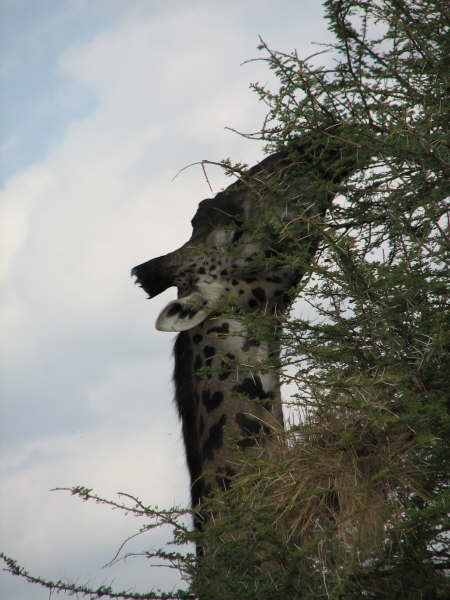ORDER:
Artiodactyla
FAMILY: Giraffidae
GENUS: Giraffa
SPECIES: camelopardalis tippelskirchi
- I.
DESCRIPTION:
-
Head-body
length 12-15 ft.; height to horn tips 15-17 ft.; weight 1700-4200
lbs (males). Females are a foot or two shorter and a couple of
hundred pounds lighter. Both sexes have horns, although the females'
horns are smaller. G.c.reticulata is a bit smaller than the other
subspecies. Varieties are told apart largely by pattern. Reticulated
are characterized by large polygons separated by cream-colored lines
rather like a large net thrown over a colored ground, hence the name
"reticulated" giraffe. Color ranges from tan to deep
chocolate brown, especially in old males who tend to darken as they
age.
-
- II.
GEOGRAPHICAL RANGE AND HABITAT:
-
Open
woodland and wooded grassland throughout sub-Saharan Africa.
Reticulated giraffe are confined to north-eastern Kenya, eastern
Sudan and Eritrea.
-
- III. DIET:
-
Highly
selective browsers feeding primarily on a variety of Acacia and
Combretum species. Over a hundred species may be eaten, depending on
what is seasonally available. Although mostly leaves and shoots are
taken, giraffe also eat flowers, vines and herbs. Giraffe have also
been seen to eat weaver-bird nests with young inside, and may chew
on bones, perhaps to gain additional minerals. An average of 16-20
hours per day are spent feeding and up to 140 lbs of fresh browse
are taken. Thorns do not seem to be a deterrent to feeding; the
long, prehensile, muscular tongue (which can be extended up to 18
inches), thick, gluey saliva, and special upper palate shape enable
the giraffe to process thorny foods. They are ruminants with a
4-chambered stomach.
-
- IV. LIFE
CYCLE/SOCIAL STRUCTURE:
-
Giraffe
form scattered herds, the compositions of which are constantly
changing. Although gregarious, the individual is the social unit in
giraffe society. Home ranges are large, about 46 sq. miles. Bulls
are non-territorial and exhibit a dominance hierarchy. Young bulls
determine dominance with "necking displays". Unknown
nomadic males may stimulate serious fighting with sledgehammer blows
being exchanged, using the side of the head. Dominant males father
most of the young. Males become sexually mature at about 42 months
but seldom have a chance to breed until 8 or more years old. Females
first conceive in their fifth year of age. Gestation is about 15
months. Calves are born in special calving grounds from a standing
female, thus dropping some 6 feet to the ground. Birth weight is
100-150 pounds; height is 6 feet. They can stand on wobbly legs
about five minutes after birth and begin to feed about 20 minutes
later. Groups of calves may be found together waiting for their
mothers to come by to nurse. Offspring begin browsing in their first
month and are rarely observed to suckle after they start eating
leaves. First year calf mortality is about 58%. Lions are the major
predator, but calves may be taken by hyenas, leopards and African
wild dogs. Life expectancy is 25 years.
-
- V. SPECIAL
ADAPTATIONS:
-
Giraffe
drink water if it is available but can go weeks without it; they
rely on the morning dew and the water content of of their food.
Their very long necks are an adaptation to feeding at high levels in
the treetops. The neck veins contain valves and a network of tiny
veins (rete mirabile) to prevent blackouts when the animal lowers
its head to drink. In addition to keeping track of predators, their
extreme long-range visual acuity enables visual communication with
other giraffe over several miles. Giraffe can run at speeds up to 35
mph.
-
- VI.
INTERPRETIVE INFORMATION:
-
There
are a number of misconceptions about giraffe. One is that they
cannot make any sound. Although generally quiet, they have been
heard to grunt, snort and bleat. Another is that they never lie
down. In fact, they often lie down to sleep, with head and neck
lying across the flanks, although these sleeping periods tend to be
brief - one to twenty minutes. The length of the forelegs in
relation to the hind has been exaggerated. In fact, they are both
about the same size (the foreleg is 1/10th longer than the hind). It
is the high dorsal spines of the shoulder which give the false
impression of a difference in limb length. They have only seven
vertebrae in their neck, the same number as man. Horns are bony
masses covered with skin and tufts of hair and are not really horns
at all. They may represent relics of pedicles from which antlers
grew ages before (since giraffe are fairly closely related to deer).
Conspecific fights are effected by neck wrestling and head banging;
defense against predators is characterized by striking out with the
forefeet. Males have extra bone deposits on their skulls for
fighting.
- VII.
STATUS IN WILD:
-
Giraffe
are still common in East and South Africa, although their
distribution in West Africa has been fragmented by poaching. The
tourist trade in giraffe hair bracelets has encouraged poaching.
|

